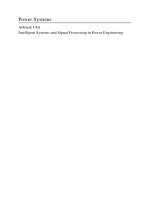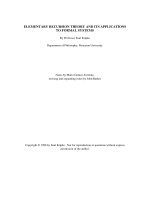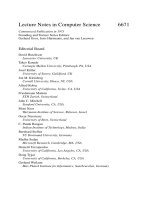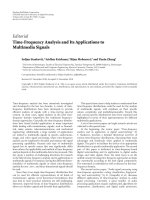soille, pesaresi, ouzounis - mathematical morphology and its applications to image and signal processing
Bạn đang xem bản rút gọn của tài liệu. Xem và tải ngay bản đầy đủ của tài liệu tại đây (21.29 MB, 494 trang )
Lecture Notes in Computer Science 6671
Commenced Publication in 1973
Founding and Former Series Editors:
Gerhard Goos, Juris Hartmanis, and Jan van Leeuwen
Editorial Board
David Hutchison
Lancaster University, UK
Takeo Kanade
Carnegie Mellon University, Pittsburgh, PA, USA
Josef Kittler
University of Surrey, Guildford, UK
Jon M. Kleinberg
Cornell University, Ithaca, NY, USA
Alfred Kobsa
University of California, Irvine, CA, USA
Friedemann Mattern
ETH Zurich, Switzerland
John C. Mitchell
Stanford University, CA, USA
Moni Naor
Weizmann Institute of Science, Rehovot, Israel
Oscar Nierstrasz
University of Bern, Switzerland
C. Pandu Rangan
Indian Institute of Technology, Madras, India
Bernhard Steffen
TU Dortmund University, Germany
Madhu Sudan
Microsoft Research, Cambridge, MA, USA
Demetri Terzopoulos
University of California, Los Angeles, CA, USA
Doug Tygar
University of California, Berkeley, CA, USA
Gerhard Weikum
Max Planck Institute for Informatics, Saarbruecken, Germany
Pierre Soille Martino Pesaresi
Georgios K. Ouzounis (Eds.)
Mathematical Morphology
and Its Applications to
Image and Signal Processing
10th International Symposium, ISMM 2011
Verbania-Intra, Italy, July 6-8, 2011
Proceedings
13
Volume Editors
Pierre Soille
Martino Pesaresi
Georgios K. Ouzounis
European Commission, Joint Research Centre
Institute for the Protection and Security of the Citizen
via Enrico Fermi, 2749, 21027, Ispra (VA), Italy
E-mail: {pierre.soille, martino.pesaresi, georgios.ouzounis}@jrc.ec.europa.eu
ISSN 0302-9743 e-ISSN 1611-3349
ISBN 978-3-642-21568-1 e-ISBN 978-3-642-21569-8
DOI 10.1007/978-3-642-21569-8
Springer Heidelberg Dordrecht London New York
Library of Congress Control Number: 2011928710
CR Subject Classification (1998): I.4.10, I.5.4, C.3, J.3, G.2, I.2.8
LNCS Sublibrary: SL 6 – Image Processing, Computer Vision, Pattern Recognition,
and Graphics
© Springer-Verlag Berlin Heidelberg 2011
This work is subject to copyright. All rights are reserved, whether the whole or part of the material is
concerned, specifically the rights of translation, reprinting, re-use of illustrations, recitation, broadcasting,
reproduction on microfilms or in any other way, and storage in data banks. Duplication of this publication
or parts thereof is permitted only under the provisions of the German Copyright Law of September 9, 1965,
in its current version, and permission for use must always be obtained from Springer. Violations are liable
to prosecution under the German Copyright Law.
The use of general descriptive names, registered names, trademarks, etc. in this publication does not imply,
even in the absence of a specific statement, that such names are exempt from the relevant protective laws
and regulations and therefore free for general use.
Typesetting: Camera-ready by author, data conversion by Scientific Publishing Services, Chennai, India
Printed on acid-free paper
Springer is part of Springer Science+Business Media (www.springer.com)
Preface
This LNCS volume on Mathematical Morphology and Its Applications to Im-
age and Signal Processing contains the full papers accepted for presentation at
the 10th International Symposium on Mathematical Morphology (ISMM 2011),
held in Intra, Italy, 6
th
–8
th
of July, 2011. ISMM is a biannual event bringing
together researchers, students, and practitioners of Mathematical Morphology
to present and discuss advances on topics ranging from new theoretical devel-
opments to novel applications, solving complex image analysis problems. ISMM
was established as the main scientific event in the field and this anniversary edi-
tion marked the tenth successful organisation in the series that was initiated in
1993 in Barcelona.
The call for papers was answered with 49 submissions. Each submitted paper
was peer-reviewed by three referees selected from the Programme Committee.
Based on their reviews, a total of 39 papers were accepted for publication in this
volume, 27 of which were selected for oral, and 12 for poster presentation. The
final programme of ISMM 2011 was divided into nine thematic areas: theory, lat-
tices and order, connectivity, image analysis, processing and segmentation, adap-
tive morphology, algorithms, remote sensing, visualisation, and applications.
The topic of special attention for ISMM 2011 was the adaptation of mor-
phological methods for the analysis of geo-spatial data. It shaped the separate
section on remote sensing consisting of five contributions, further backed by four
papers on the topics of connectivity and algorithms. The symposium programme
was enriched by the following three keynote lectures:
– “Applications of Discrete Calculus in Computational Science” by Leo Grady
(Siemens Corporate Research);
– “Morphological Profiles in Classification of Remote Sensing Imagery” by J´on
Atli Benediktsson (University of Iceland);
– “Mathematical Morphology in Computer Graphics, Scientific Visualization
and Visual Exploration” by Jos B.T.M. Roerdink (University of Groningen).
ISMM 2011 was organised by the Institute for the Protection and Security of
the Citizen (IPSC), of the European Commission’s Joint Research Centre in
Ispra, Italy. The success of the event is attributed to the joint effort of many
individuals. In particular, we wish to thank all the authors who accepted our
invitation, the members of the Programme Committee for delivering thorough re-
views of the submitted manuscripts, the invited speakers for offering three high-
quality lectures, and the Session Chairs for running the symposium smoothly.
We wish to acknowledge the IPSC (JRC) for supporting this event, and the
VI Preface
hotel Il Chiostro, Intra, for facilitating the symposium and taking care of the
organisation of the social event. Special thanks go to Ana-Maria Duta (IPSC)
for assisting in organisational issues. All submitted material was managed by
the online EasyChair conference management system.
April 2011 P. Soille, M. Pesaresi, and G.K. Ouzounis
Ispra, Italy EC Joint Research Centre
ISMM 2011 Organisation
ISMM 2011 was organised by the Geo-spatial Information Analysis for Security
and Stability Action of the Global Security and Crisis Management Unit, In-
stitutefortheProtectionand Security of the Citizen, Joint Research Centre,
European Commission.
Chairing Committee
Pierre Soille EC Joint Research Centre, Ispra, Italy
Martino Pesaresi EC Joint Research Centre, Ispra, Italy
Georgios K. Ouzounis EC Joint Research Centre, Ispra, Italy
Steering Committee
Junior Barrera Universidade de S˜ao Paolo, Brazil
Isabelle Bloch T´el´ecom ParisTech (ENST), France
Renato Keshet HP Labs, Haifa, Israel
Petros Maragos National Technical University of
Athens, Greece
Fernand Meyer Mines ParisTech, Fontainebleau, France
Jos B.T.M. Roerdink University of Groningen, The Netherlands
Christian Ronse Universit´e de Strasbourg, France
Philippe Salembier Universita Polyt`ecnica de
Catalunya, Barcelona, Spain
Pierre Soille EC Joint Research Centre, Ispra, Italy
Hugues Talbot Universit´e Paris-Est, ESIEE, France
Michael H.F. Wilkinson University of Groningen, The Netherlands
Local Organising Committee
Ana-Maria Duta
Georgios K. Ouzounis
Martino Pesaresi
Pierre Soille
Invited Speakers
J´on Atli Benediktsson University of Iceland, Reykjavik, Iceland
Leo Grady Siemens Corporate Research, Princeton,
USA
Jos B.T.M. Roerdink University of Groningen, The Netherlands
VIII ISMM 2011 Organisation
Programme Committee
Jes´us Angulo
Akira Asano
Isabelle Bloch
Gunilla Borgefors
Michael Buckley
Bernhard Burgeth
Jocelyn Chanussot
Jean Cousty
Jos´eCrespo
Etienne Decenci`ere
Adrian Evans
Jacopo Grazzini
Thierry G´eraud
Lionel Gueguen
Allan Hanbury
Marcin Iwanowski
Andrei Jalba
Dominique Jeulin
Renato Keshet
Ullrich K¨othe
S´ebastien Lef`evre
Roberto Lotufo
Cris L. Luengo Hendriks
Beatriz Marcotegui
Fernand Meyer
Annick Montanvert
Laurent Najman
Nicolas Passat
Jos B.T.M. Roerdink
Christian Ronse
Philippe Salembier
Gabriella Sanniti di
Baja
Jean Serra
Hugues Talbot
Iv´an Ramon
Terol-Villalobos
Erik Urbach
Marc Van
Droogenbroeck
Michel Westenberg
Michael Wilkinson
Additional Reviewers
Pascal Gwosdek
Andr´eK¨orbes
Benjamin Perret
Let´ıcia Rittner
Oliver Vogel
Table of Contents
Theory
Sparse Mathematical Morphology Using Non-negative Matrix
Factorization 1
Jes´us Angulo and Santiago Velasco-Forero
Fuzzy Bipolar Mathematical Morphology: A General Algebraic
Setting 13
Isabelle Bloch
Image Decompositions and Transformations as Peaks and Wells 25
Fernand Meyer
Lattices and Order
Grain Building Ordering 37
Jean Serra
Orders on Partial Partitions and Maximal Partitioning of Sets 49
Christian Ronse
Connective Segmentation Generalized to Arbitrary Complete
Lattices 61
Seidon Alsaody and Jean Serra
Connectivity
Hyperconnections and Openings on Complete Lattices 73
Michael H.F. Wilkinson
Toward a New Axiomatic for Hyper-Connections 85
Benjamin Perret, S´ebastien Lef`evre, and Christophe Collet
Preventing Chaining through Transitions While Favouring It within
Homogeneous Regions 96
Pierre Soille
Pattern Spectra from Partition Pyramids and Hierarchies 108
Georgios K. Ouzounis and Pierre Soille
Frequent and Dependent Connectivities 120
Lionel Gueguen and Pierre Soille
X Table of Contents
Image Analysis, Processing, and Segmentation
Stochastic Multiscale Segmentation Constrained by Image Content 132
Luc Gillibert and Dominique Jeulin
Pattern Recognition Using Morphological Class Distribution Functions
and Classification Trees 143
Marcin Iwanowski and Michal Swiercz
Object Descriptors Based on a List of Rectangles: Method and
Algorithm 155
Marc Van Droogenbroeck and S´ebastien Pi´erard
Ultimate Opening and Gradual Transitions 166
Beatriz Marcotegui, Jorge Hern´andez, and Thomas Retornaz
Spatio-temporal Quasi-Flat Zones for Morphological Video
Segmentation 178
Jonathan Weber, S´ebastien Lef`evre, and Pierre Gan¸carski
Primitive and Grain Estimation Using Flexible Magnification for a
Morphological Texture Model 190
Lei Yang, Liang Li, Chie Muraki Asano, and Akira Asano
Geodesic Attributes Thinnings and Thickenings 200
Vincent Morard, Etienne Decenci`ere, and Petr Dokladal
Adaptive Morphology
Morphological Bilateral Filtering and Spatially-Variant Adaptive
Structuring Functions 212
Jes´us Angulo
General Adaptive Neighborhood Viscous Mathematical Morphology 224
Johan Debayle and Jean-Charles Pinoli
Spatially-Variant Structuring Elements Inspired by the Neurogeometry
of the Visual Cortex 236
Miguel A. Luengo-Oroz
Algorithms
Towards a Parallel Topological Watershed: First Results 248
Jo¨el van Neerbos, Laurent Najman, and Michael H.F. Wilkinson
Advances on Watershed Processing on GPU Architecture 260
Andr´eK¨orbes, Giovani Bernardes Vitor,
Roberto de Alencar Lotufo, and Janito Vaqueiro Ferreira
Table of Contents XI
Incremental Algorithm for Hierarchical Minimum Spanning Forests and
Saliency of Watershed Cuts 272
Jean Cousty and Laurent Najman
Component-Hypertrees for Image Segmentation 284
Nicolas Passat and Benoˆıt Naegel
Fast Streaming Algorithm for 1-D Morphological Opening and Closing
on 2-D Support 296
Jan Bartovsky, Petr Dokladal, Eva Dokladalova, and Michel Bilodeau
Remote Sensing
Hierarchical Analysis of Remote Sensing Data: Morphological Attribute
Profiles and Binary Partition Trees 306
Jon Atli Benediktsson, Lorenzo Bruzzone, Jocelyn Chanussot,
Mauro Dalla Mura, Philippe Salembier, and Silvia Valero
Self-dual Attribute Profiles for the Analysis of Remote Sensing
Images 320
Mauro Dalla Mura, Jon Atli Benediktsson, and Lorenzo Bruzzone
Concurrent Computation of Differential Morphological Profiles on
Giga-Pixel Images 331
Michael H.F. Wilkinson, Pierre Soille, Martino Pesaresi, and
Georgios K. Ouzounis
Hierarchical Segmentation of Multiresolution Remote Sensing Images 343
Camille Kurtz, Nicolas Passat, Anne Puissant, and Pierre Gan¸carski
Mathematical Morphology for Vector Images Using Statistical Depth 355
Santiago Velasco-Forero and Jesus Angulo
Visualisation
Mathematical Morphology in Computer Graphics, Scientific
Visualization and Visual Exploration 367
Jos B.T.M. Roerdink
Surface Reconstruction Using Power Watershed 381
Camille Couprie, Xavier Bresson, Laurent Najman,
Hugues Talbot, and Leo Grady
Voxel-Based Assessment of Printability of 3D Shapes 393
Alexandru Telea and Andrei Jalba
A Comparison of Two Tree Representations for Data-Driven Volumetric
Image Filtering 405
Andrei C. Jalba and Michel A. Westenberg
XII Table of Contents
Applications
Optimal Path: Theory and Models for Vessel Segmentation 417
Jean Stawiaski
Cytology Imaging Segmentation Using the Locally Constrained
Watershed Transform 429
N. B´eliz-Osorio, J. Crespo, M. Garc´ıa-Rojo, A. Mu˜noz, and
J. Azpiazu
Stochastic Modeling of a Glass Fiber Reinforced Polymer 439
Hellen Altendorf and Dominique Jeulin
Segmentation of Cracks in Shale Rock 451
Erik R. Urbach, Marina Pervukhina, and Leanne Bischof
Size and Spatial Distributions Characterization of Graphite Nodules
Based on Connectivity by Dilations 461
Luis A. Morales-Hern´andez, Ana M. Herrera-Navarro,
Federico Manriquez-Guerrero, Hayde Peregrina-Barreto, and
Iv´an R. Terol-Villalobos
Topic Segmentation: Application of Mathematical Morphology to
Textual Data 472
S´ebastien Lef`evre and Vincent Claveau
Author Index 483
Sparse Mathematical Morphology Using
Non-negative Matrix Factorization
Jesús Angulo and Santiago Velasco-Forero
CMM-Centre de Morphologie Mathématique, Mathématiques et Systèmes, MINES
ParisTech; 35, rue Saint Honoré, 77305 Fontainebleau Cedex, France
{jesus.angulo,santiago.velasco}@mines-paristech.fr
Abstract. Sparse modelling involves constructing a succinct represen-
tation of initial data as a linear combination of a few typical atoms of
a dictionary. This paper deals with the use of sparse representations
to introduce new nonlinear operators which efficiently approximate the
dilation/erosion. Non-negative matrix factorization (NMF) is a dimen-
sional reduction (i.e., dictionary learning) paradigm particularly adapted
to the nature of morphological processing. Sparse NMF representations
are studied to introduce pseudo-morphological binary dilations/erosions.
The basic idea consists in processing exclusively the image dictionary and
then, the result of processing each image is approximated by multiplying
the processed dictionary by the coefficient weights of the current im-
age. These operators are then extended to grey-level images by means of
the level-set decomposition. The performance of the present method is
illustrated using families of binary shapes and face images.
1 Introduction
Mathematical morphology [11,4] is a nonlinear image processing methodology
based on the application of lattice theory to spatial structures. Morphological
filters and transformations are useful for various image processing tasks [12],
such as denoising, contrast enhancement, multi-scale decomposition, feature ex-
traction and object segmentation. In addition, morphological operators are de-
fined using very intuitive geometrical notions which allows us the perceptual de-
velopment and interpretation of complex algorithms by combination of various
operators.
Let E be a space of points, which is considered here as a finite digital space
of the pixels of the image, i.e., E ⊂ Z
2
such that N = |E| is the number of
pixels. Image intensities are numerical values, which ranges in a closed subset
T of
R = R ∪{−∞, +∞}; for example, for an image of discrete L values, it
can be assumed T = {t
1
,t
2
, ···,t
L
}. Then, a binary image X is modelled as a
subset of E, i.e., X ∈P(E); a grey-level image f(p
i
),wherep
i
∈ E are the pixel
coordinates, is a numerical function E →T, i.e., f ∈F(E,T ).Inmathematical
morphology, an operator ψ is a map transforming an image into an image. There
are thus operators on binary images, i.e., maps P(E) →P(E);orongrey-level
images, i.e., maps F(E, T ) →F(E,T ).
P. Soille, M. Pesaresi, and G.K. Ouzounis (Eds.): ISMM 2011, LNCS 6671, pp. 1–12, 2011.
c
Springer-Verlag Berlin Heidelberg 2011
2 J. Angulo and S. Velasco-Forero
Sparse coding and dictionary learning, where data is assumed to be well rep-
resented as a linear combination of a few elements from a dictionary, is an active
research topic which leads to state-of-the-art results in image processing appli-
cations, such as image denoising, inpainting or demosaicking [3,9,14]. Inspired
by these studies, the aim of this paper is to explore how image sparse represen-
tations can be useful to efficiently calculate morphological operators.
Motivation and outline of the approach. In many practical situations, a
collection of M binary or grey-level images (each image having N pixels) should
be analysed by applying the same morphological operator (or a series of oper-
ators) to each image. If one considers that the content of the various images
is relatively similar, we can expect that the initial collection can be efficiently
projected into a dimensionality reduced image space. Then, the morphological
operator (or an equivalent operator) can be applied to the reduced set of images
of the projective space, in such a way that the original processed image is ap-
proximately obtained by projecting back to the initial space. Typical examples
of image families which can be fit in this framework are: i) collection of shapes
or a database of face images, ii) the spectral bands of a hyperspectral image, iii)
the set of patches of a large image. The rationale behind this kind of approach is
the hypothesis that the intrinsic dimension of the image collection is lower than
N ×M. Usually the subspace representation involves deriving a set of basis com-
ponents (or dictionary composed of atoms) using linear techniques like PCA or
ICA. The projection coefficients for the linear combinations in the above meth-
ods can be either positive or negative, and such linear combinations generally
involve complex cancellations between positive and negative numbers. There-
fore, these representations lack the intuitive meaning of “adding parts to form
a whole”. This property is particularly problematic in the case of mathematical
morphology since the basic binary operator, the dilation of a set, is defined as the
operator which commutes with the union of parts of the set. Non-negative matrix
factorization (NMF) [6] imposes the non-negativity constraints in learning basis
images: the pixels values of resulting images as well as the coefficients for the
reconstruction are all non-negative. This ensures that NMF is a procedure for
learning a parts-based representation [6]. In addition, sparse modelling involves
for the construction of a succinct representation of some data as a combination
of a few typical patterns (few atoms of the dictionary) learned from the data
itself. Hence, the notion of sparse mathematical morphology introduced for the
first time in this paper is based on sparse NMF.
Paper organisation. This paper is structured as follows. Section 2 reviews
the notion of NMF and the various algorithms proposed in the state-of-the-art,
including the sparse variants. The use of NMF representations for implementing
sparse pseudo-morphological binary dilations/erosions is introduced in Section
3. Using the level set decomposition of numerical functions, the extension to
grey-level images of this morphological sparse processing is tackled in Section 4.
Conclusions and perspectives are finally given in Section 5.
Sparse Mathematical Morphology Using Non-negative Matrix Factorization 3
2 Non-negative Matrix Factorization and Variants
Definition. Let us assume that our data consists of M vectors of N non-negative
scalar variables. Denoting the column vector v
j
, j =1, ···,M,thematrixof
data is obtained as V =(v
1
, ···, v
M
) (each v
j
is the j-th column of V), with
|v
j
| = N.IfweanalyzeM images of N pixels, these images can be stored in
linearized form, so that each image will be a column vector of the matrix.
Given the non-negative matrix V ∈ R
N×M
, V
i,j
≥ 0, NMF is a linear non-
negative approximate data decomposition into the two matrices W ∈ R
N×R
and
H ∈ R
R×M
such that
V ≈ WH, s.t. W
i,k
, H
k,j
≥ 0, (1)
where usually R M (dimensionality reduction). Each of the R columns of
W contains a basis vector w
k
and each row of H contains the coefficient vector
(weights) h
j
corresponding to vector v
j
: v
j
=
R
k=1
w
k
H
k,j
= Wh
j
.Usingthe
modern terminology, the matrix W contains the dictionary and H the encoding.
A theoretical study of the properties of NMF representation has been achieved
in [2] using geometric notions: NMF is interpreted as the problem of finding a
simplicial cone which contains the data points in the positive orthant, or in other
words, NMF is a conical coordinate transformation.
Algorithms for computing NMF. The factorization V ≈ WH is not nec-
essarily unique, and the optimal choice of matrices W and H depends on the
cost function that minimizes the reconstruction error. The most widely used is
the Euclidean distance: minimize V − WH
2
2
=
i,j
(V
i,j
− (WH)
i,j
)
2
with
respect to W and H, subject to the constraints W, H > 0. Although the min-
imization problem is convex in W and H separately, it is not convex in both
simultaneously. In [7] is proposed a multiplicative good performance algorithm
to implement this optimization problem. They proved that the cost function is
nonincreasing at the iteration and the algorithm converges at least to a local
optimal solution. More precisely, the update rules for both matrices are:
H
k,j
← H
k,j
(W
T
V)
k,j
(W
T
WH)
k,j
; W
i,k
← W
i,k
(VH
T
)
i,k
(WHH
T
)
k,j
Another useful cost function, also considered in [7], is the Kullback-Leibler (KL)
divergence, which leads also quite simple multiplicative update rules. In [8], it
was proposed a variant of KL divergence NMF, which is named Local NMF
(LNMF), aiming at learning spatially localized components (by minimizing the
number of basis R to represent V and by maximizing the energy of each retained
components) as well as imposing that different bases should be as orthogonal as
possible (in order to minimize redundancy between the different bases). The
multiplicative update rules for LNMF are given by
H
k,j
←
H
k,j
i
V
i,j
W
i,k
(WH)
i,k
; W
i,k
← W
i,k
j
V
i,j
H
k,j
(WH)
i,j
j
H
k,j
; W
i,k
←
W
i,k
i
W
i,k
4 J. Angulo and S. Velasco-Forero
NMF with sparseness constraints. A very powerful framework to add a
degree of sparseness in the basis vectors W and/or the coefficients H was intro-
duced in [5]. The sparseness measure σ of a vector v ∈ R
N×1
used in [5] is based
on the relationship between the L
1
norm and the L
2
norm: σ(v)=
√
N−v
1
/v
2
√
N−1
.
This function is maximal at 1 iff v contains only a single non-zero component,
and takes a value of 0 iff all components are equal (up to signs). Then, matrix W
and H are solved by the problem (1) under additional constraints σ(w
k
)=S
w
and σ(h
j
)=S
h
,whereS
w
and S
h
are respectively the desired sparseness of W
and H. The algorithm introduced in [5] is a projected gradient descent algo-
rithm (additive update rule), which takes a step in the direction of the negative
gradient, and subsequently projects onto the constraint space. The most sophis-
ticated step finds, for a given vector v, the closest non-negative vector u with
agivenL
1
norm and a given L
2
norm, see technical details in [5]. Sparseness
is controlled explicitly with a pair of parameters that is easily interpreted; in
addition, the number of required iterations grows very slowly with the dimen-
sionality of the problem. In fact, for all the empirical tests considered in this
paper, we have used the MATLAB code for performing NMF and its various
extensions (LNMF, sparse NMF) provided by P. Hoyer [5].
Besides the spareness parameters (S
w
,S
h
), a crucial parameter to be chosen
in any NMF algorithm is the value of R, that is, the number of basis of pro-
jective reduced space. Any dimensionality reduction technique, such as PCA,
requires also to fix the number of components. In PCA, the components are
ranked according to the second-order statistical importance of the components
and each one has associated a value of the represented variance; whereas in
NMF the selection R can be evaluated only a posteriori, by evaluating the error
of reconstruction.
3 Sparse Binary Pseudo-dilations and Pseudo-erosions
Let X = {X
1
, ···,X
M
} be a collection of M binary shapes, i.e., X
j
∈P(E).For
each shape X
j
,letx
j
(i):I →{0, 1},withi ∈ I = {1, 2, ···,N} and N = |E|,
be its characteristic vector : ∀X
j
∈P(E),wehavex
j
(i)=1if p
i
∈ X
j
and
x
j
(i)=0if p
i
∈ X
c
j
. Then the shape family X has associated a data matrix
V ∈{0, 1}
N×M
, where each characteristic vector corresponds to one column,
i.e., V
i,j
= x
j
(i).
Sparse NMF approximations to binary sets. After computing NMF op-
timization on data V, for a given dimensionality R, an approximation to V is
obtained. More precisely, if we denote by φ
k
(p
i
):E → R
+
the basis images
associated to the basis matrix W, i.e., φ
k
(p
i
)=W
i,k
, the following image is
obtained as
a
X
j
(p
i
)=
R
k=1
φ
k
(p
i
)H
k,j
(2)
It is obvious that without any additional constrains, function a
X
(p
i
) is neither a
binary image not even strictly defined in interval [0, 1] (the value can be slightly
Sparse Mathematical Morphology Using Non-negative Matrix Factorization 5
> 1). Hence, a thresholding operation at value α is required to impose a binary
approximate set
X
j
to each initial shape X
j
, i.e.,
X
j
NMF
−−−−→
X
j
: p
i
∈
X
j
if a
X
(p
i
) >α (3)
We propose to fix, for all the examples of the paper, the threshold value to
α =0.4, in order to favor the reconstruction of X
j
against its complement.
Let us consider a practical example of binary image collection X ,usingM =
100 images of the Fish shape database (N = 400×200). Fig. 1 depicts the corre-
sponding basis images for various NMF algorithms: we have fixed R =10for all
the cases (relatively strong dimensionality reduction). We observe that standard
NMF produces a partial part-based representation, which includes also almost
complete objects for outlier shapes (basis 2-upper-center and 5-center-center).
As expected, LNMF produces more local decompositions, however the orthogo-
nality constraints involves also an atomization of some common parts. A similar
problem arises for Sparse-NMF when S
w
=0(constraint of sparsity in basis
matrix W). When the sparsity constraint is limited to S
h
, with a typical value
around 0.6, the obtained dictionary of shapes is less local, but in exchange,
this constraint involves that each binary shapes is reconstructed using a limited
number of atoms. The various groups of fish shapes are therefore better approxi-
mated by the latter case than using the other NMF algorithms. The comparison
of Fig. 2 illustrates the better performance of Sparse-NMF (S
w
=0, S
h
=0.6)
with respect to the others.
Sparse max-approximation to binary dilation. The two fundamental mor-
phological operators are the dilation and the erosion, which are defined respec-
tively as the operators which preserve the union and the intersection. Given a
structuring element B ⊆ E, i.e., a set defined at the origin which introduces
the shape/size of the operator, the dilation of a binary image X by B and the
erosion of a binary image X by B are defined respectively by by [11,4,1]
δ
B
(X)=∪{B(p
i
)| p
i
∈ X} , (4)
and
ε
B
(X)={p
i
∈ E| B(p
i
) ⊆ X} , (5)
where B(p
i
) is the structuring element centered at pixel p
i
.Inthecaseofnu-
merical functions f ∈F(E,T ), which are considered in detail in next section,
the dilation of a grey-level image is defined by [4,12,1]
δ
B
(f)(p
i
)=
f(p
m
)| f (p
m
)=sup[f (p
n
)] ,p
n
∈
ˇ
B(p
i
)
, (6)
and the dual grey-level erosion is given by [4,12,1]
ε
B
(f)(p
i
)={f(p
m
)| f (p
m
)=inf[f(p
n
)] ,p
n
∈ B(p
i
)} . (7)
where
ˇ
B(p
i
) is the transposed structuring element centered at pixel p
i
.IfB is
symmetric with respect to the origin
ˇ
B = B.
6 J. Angulo and S. Velasco-Forero
(a) Original binary images (b) NMF basis images
(c) LNMF basis images (d) Sparse-NMF basis images (S
w
=0.5,S
h
=0.5)
(e) Sparse-NMF basis images (S
w
=0.6,S
h
=0) (f) Sparse-NMF basis images (S
w
=0,S
h
=0.6)
Fig. 1. Non-negative representation of binary shapes. A collection of M = 100 shapes
has been used in the NMF experiments (in (a) is given only a selection of 9 shapes),
where the number of reduced dimensions has been fixed to R =10(in the examples
are given the first 9 basis images).
The characteristic function of set X, denoted ξ
X
: E →{0, 1}, is defined by
∀X ∈P(E), ∀p
i
∈ E, ξ
X
(p
i
)=
1 if p
i
∈ X
0 if p
i
∈ X
c
(8)
For a function f : E →T,thethresholded set at value t ∈T is a mapping from
F(E, T ) to P(E) given by [11]
t
(f)={p
i
∈ E| f (p
i
) ≥ t} . (9)
Using these transformations it is obvious that the binary dilation (5) can be
computed using the numerical operator (6), i.e.,
δ
B
(X)=
1
(δ
B
(ξ
X
)(p
i
)) . (10)
We know that given a set defined as the union of a family of sets, i.e., X =
∪
k∈K
X
k
, the corresponding dilation is
δ
B
(X)=δ
B
(∪
k∈K
X
k
)=∪
k∈K
δ
B
(X
k
). (11)
Sparse Mathematical Morphology Using Non-negative Matrix Factorization 7
S
w
=0.6 S
h
=0 S
w
=0S
h
=0.6
Fig. 2. Sparse NMF approximations to binary sets: (a) three original shapes X
j
;(b)-(e)
Top, reconstructed function a
X
j
and Bottom, approximate set
X
j
It is also easy to see that
δ
B
(X)=
1
δ
B
min
1,
k∈K
ξ
X
k
(p
i
)
=
1
k∈K
δ
B
(ξ
X
k
(p
i
))
. (12)
In fact, the justification for using NMF in sparse mathematical morphology arises
from equations (11) and (12).
Coming back to the NMF reconstruction, expressions (2) and (3), we can now
write
X
j
≈
X
j
=
α
R
k=1
φ
k
(p
i
)H
k,j
. (13)
Hence, we propose to introduce the following nonlinear operator, named sparse
max-approx imation to binary dilation,
D
B
(X
j
)=
α
R
k=1
δ
B
(φ
k
)(p
i
)H
k,j
. (14)
Note that by the positivity of H
k,j
,wehaveδ
B
(φ
k
(p
i
)H
k,j
)=δ
B
(φ
k
)(p
i
)H
k,j
.
We can say that δ
B
(X
j
) ≈ D
B
(X
j
), however neither the increasiness nor the
extensitivity of D
B
(X
j
) w.r.t. X
j
can be guaranteed and consequently, this op-
erator is not a morphological dilation. In other terms, in order to approximate
the dilation by B of any of the M sets X
j
, we only need to calculate the dilation
of the R basis images. In addition, the sparsity of H involves that only a limited
number of dilated atoms are required for each X
j
.
Dual sparse max-approx imation to binary erosion. One of the most inter-
esting properties of mathematical morphology is the duality by the complement
8 J. Angulo and S. Velasco-Forero
of pair of operators. Hence, the binary erosion of set X by B can be defined as
the dual operator to the dilation: ε
ˇ
B
(X)=(δ
B
(X
c
))
c
. Using this property, we
propose to define the sparse max-approximation to binary erosion as
E
B
(X
j
)=
α
R
k=1
δ
B
[φ
k
]
(p
i
)
H
k,j
, (15)
where the complement basis images are defined by [φ
k
(p
i
)] = max(W
i,k
) −
φ
k
(p
i
)+min(W
i,k
).
The results of D
B
(X
j
) and E
B
(X
j
) for three examples of the Fish shapes,
compared with respect to the standard binary dilation and erosion, are given in
Fig. 3. We have compared in particular the sparse max-approximation for the
standard NMF and for the Sparse-NMF.
δ
B
(X
j
) ε
B
(X
j
)
D
B
(X
j
) E
B
(X
j
)
D
B
(X
j
) E
B
(X
j
)
Fig. 3. Comparison of dilation/erosion (a)/(b) vs. sparse pseudo operators for three
examples of the Fish shapes. It is compared in particular the sparse max-approximation
to dilation/erosion for the standard NMF (c)/(d) and for the Sparse-NMF (e)/(f), with
(S
w
=0,S
h
=0.6). The structuring element B is a square of 5 × 5 pixels.
4 Extension to Grey-Level Images
We deal in this section with families of discrete grey-level images, i.e., F =
{f
1
(p
i
), ··· ,f
M
(p
i
)},withf
j
(p
i
) ∈F(E, T ), T = {t
1
,t
2
, ···,t
L
} with (t
l+1
−
t
l
)=Δt. The thresholded set of f
j
at each t
l
, i.e., X
t
l
j
=
t
l
(f
j
), is called the
cross-section or level-set at t
l
. The set of cross-sections constitutes a family of
decreasing sets: t
λ
≥ t
μ
⇒ X
t
λ
⊆ X
t
μ
and X
t
λ
= ∩{X
t
μ
,μ < λ}. Any image
f
j
can be viewed as an unique stack of its cross-sections, which leads to the
following reconstruction property:
f
j
(p
i
)=sup{t
l
| p
i
∈ X
t
l
j
},t
l
∈T. (16)
We prefer here to consider the alternative reconstruction [13,10] using a numer-
ical sum of the characteristic function of cross sections:
f
j
(p
i
)=Δt
L
l=1
ξ
X
t
l
j
(p
i
). (17)
Sparse Mathematical Morphology Using Non-negative Matrix Factorization 9
It is well known in mathematical morphology that any binary increasing oper-
ator, such as the dilation and erosion, can be generalised to grey-level images by
applying the binary operator to each cross-section, and then by reconstructing
the corresponding grey-level image [11,10], i.e.,
δ
B
(f
j
)(p
i
)=Δt
L
l=1
ξ
δ
B
(
X
t
l
j
)
(p
i
), and ε
B
(f
j
)(p
i
)=Δt
L
l=1
ξ
ε
B
(
X
t
l
j
)
(p
i
). (18)
Consider now that each image of the initial grey-level family F of M images
is decomposed into its L cross-sections. Hence, we have
F = {f
1
, ···,f
M
} →X = {X
t
1
1
,X
t
2
1
··· ,X
t
L
1
, ···,X
t
L
M−1
,X
t
1
M
, ···,X
t
L
M
},
where X is a family of M
= M × L binary images. Therefore, we can use
NMF algorithms, for a given dimension R, to approximate each set X
t
l
j
and
then approximate the corresponding function f
j
(p
i
). Using the results of the
previous section, we are able now to introduce the following definition for the
sparse max-approximation to grey-level dilation and er o sion given respectively
by:
D
B
(f
j
)(p
i
)=Δt
L
l=1
ξ
D
B
(
X
t
l
j
)
(p
i
), (19)
and
E
B
(f
j
)(p
i
)=Δt
L
l=1
ξ
E
B
(
X
t
l
j
)
(p
i
). (20)
with
D
B
X
t
l
j
=
α
R
k=1
δ (φ
k
)(p
i
)H
k,j+l
;
E
B
X
t
l
j
=
α
R
k=1
δ
B
[φ
k
]
(p
i
)
H
k,j+l
.
We must point out again that these approximate nonlinear operators do not
satisfy the standard properties of grey-level dilation and erosion. The precise
properties of D
B
(f
j
) and E
B
(f
j
) will be studied in detail in a subsequent paper.
Fig. 4 illustrates the behaviour of sparse max-approximation to grey-level di-
lation and erosion. This preliminary experiment deals with images from the ORL
face database. In this particular case, the results obtained using the standard
NMF are significantly better than those obtained using any Sparse-NMF version.
In fact, as we can observe, the quality of the sparse max-approximation to
dilation and to erosion, for a particular image, depends on the quality of the
initial NMF reconstruction of the image. For instance, the first face (man with
glasses) is not very well approximated with the learned NMF basis and hence,
its approximated dilation and erosion are also unsatisfactory. On the contrary,
in the case of the last image (woman), the results are more appropriate.
10 J. Angulo and S. Velasco-Forero
(a) Original images f
j
(p
i
)
(b) NMF approximation
f
j
(p
i
)
(c) Dilated images δ
B
(f
j
)(p
i
)
(d) Sparse max-approximation dilat. D
B
(f
j
)(p
i
)
(e) Eroded images ε
B
(f
j
)(p
i
)
(f) Sparse max-approximation erod. E
B
(f
j
)(p
i
)
Fig. 4. Four examples of the ORL face database (a) (quantized in L =10grey-
levels) and corresponding approximated image using standard NMF. Comparison of
dilation/erosion (c)/(d) vs. sparse max-approximation to dilation/erosion for the stan-
dard NMF (e)/(f). A collection of M =20faces has been used in the NMF experiments
where the number of reduced dimensions for the binary matrix V has been fixed to
R =75(note that M
=20× 10 = 200 dimensions). The structuring element B is a
square of size 3 × 3 pixels.
Sparse Mathematical Morphology Using Non-negative Matrix Factorization 11
In any case, this is only a first experiment and a more concise investigation
of the effect of variations of the parameters would be studied in ongoing re-
search. Typically, we need to evaluate quantitatively, for a given operator, the
approximation power for different sizes of structuring element as well as the ap-
proximation power of the morphological operators with respect to the degree of
approximation of the initial image. In addition, the influence on the approxi-
mated morphological operators of dimensionality R and of the parameters S
w
and S
h
from Sparse NMF should be also evaluated. It will be also probably
useful a direct comparison to another dimensionality reduction technique, typi-
cally PCA, in order to have a better judgment of the potential of the presented
approach.
5 Conclusions and Perspectives
We have introduced the notion of sparse binary and grey-level pseudo-dilations
and erosions using NMF sparse representation. The first results are relatively
encouraging and they open a new avenue to study how the current paradigm of
sparse modelling (based mainly on linear operations) can be particularised to
the nonlinear morphological framework.
Besides a deeper experimental quantitative analysis, as discussed above, in
ongoing research, we will focus, on the one hand, on NMF representations which
produces binary basis images, see for instance [15], which is still a quite open
problem. On the other hand, we will study in deep the properties of the sparse
max-approximation to dilation/erosion, as well as consider alternative extensions
to the grey-level case. Finally, the construction of more complex operators than
dilation/erosion, and eventually the introduction of new ones, and their possible
applications for inverse problems (regularisation, debluring, etc.) will be also
foreseen.
References
1. Bloch, I., Heijmans, H., Ronse, C.: Mathematical Morphology. In: Aiello, M.,
Pratt-Hartmann, I., van Benthem, J. (eds.) Handbook of Spatial Logics, ch. 14,
pp. 857–944. Springer, Heidelberg (2007)
2. Donoho, D., Stodden, V.: When does non-negative matrix factorization give a
correct decomposition into parts? In: Advances in Neural Information Processing
16 (Proc. NIPS 2003). MIT Press, Cambridge (2004)
3. Elad, M., Aharon, M.: Image denoising via sparse and redundant representations
over learned dictionaries. IEEE Trans. on Image Proc. 15(12), 3736–3745 (2006)
4. Heijmans, H.J.A.M.: Morphological Image Operators. Academic Press, Boston
(1994)
5. Hoyer, P.: Non-negative Matrix Factorization with Sparseness Constraints. J.
Mach. Learn. Res. 5, 1457–1469 (2004)
6. Lee, D.D., Seung, H.S.: Learning the parts of objects by non-negative matrix fac-
torization. Nature 401(6755), 788–791 (1999)
12 J. Angulo and S. Velasco-Forero
7. Lee, D.D., Seung, H.S.: Algorithms for non-negative matrix factorization. In:
Advances in Neural Information Processing 13 (Proc. NIPS 2000). MIT Press,
Cambridge (2001)
8. Li, S.Z., Hou, X., Zhang, H., Cheng, Q.: Learning spatially localized parts-based
representations. In: Proc. IEEE Conf. on Computer Vision and Pattern Recognition
(CVPR), Hawaii, USA, vol. I, pp. 207–212 (2001)
9. Mairal, J., Elad, M., Sapiro, G.: Sparse representation for color image restoration.
IEEE Trans. on Image Proc. 17(1), 53–69 (2008)
10. Ronse, C.: Bounded variation in posets, with applications in morphological im-
age processing. In: Passare, M. (ed.) Proceedings of the Kiselmanfest 2006, Acta
Universitatis Upsaliensis, vol. 86, pp. 249–281 (2009)
11. Serra, J.: Image Analysis and Mathematical Morphology. Image Analysis and
Mathematical Morphology, vol. I. Theoretical Advances, vol. II. Academic Press,
London (1982) (1988)
12. Soille, P.: Morphological Image Analysis. Springer, Berlin (1999)
13. Wendt, P.D., Coyle, E.J., Gallagher, N.C.: Stack Filters. IEEE Trans. on Acoustics,
Speech, and Signal Processing 34(4), 898–911 (1986)
14. Yu, G., Sapiro, G., Mallat, S.: Solving Inverse Problems with Piecewise Linear
Estimators: From Gaussian Mixture Models to Structured Sparsity. IEEE Trans.
on Image Processing (2011)
15. Yuan, Y., Li, X., Pang, Y., Lu, X., Tao, D.: Binary Sparse Nonnegative Matrix
Factorization. IEEE Trans. on Circuits and Systems for Video Technology 19(5),
772–777 (2009)
Fuzzy Bipolar Mathematical Morphology:
A General Algebraic Setting
Isabelle Bloch
T´el´ecom ParisTech - CNRS LTCI - Paris, France
Abstract. Bipolar information is an important component in informa-
tion processing, to handle both positive information (e.g. preferences)
and negative information (e.g. constraints) in an asymmetric way. In
this paper, a general algebraic framework is proposed to handle such in-
formation using mathematical morphology operators, leading to results
that apply to any partial ordering.
Keywords: Bipolar information, fuzzy bipolar dilation and erosion, bipo-
lar connectives.
1 Introduction
A recent trend in contemporary information processing focuses on bipolar in-
formation, both from a knowledge representation point of view, and from a
processing and reasoning one. Bipolarity is important to distinguish between
(i) positive information, which represents what is guaranteed to be possible, for
instance because it has already been observed or experienced, and (ii) negative
information, which represents what is impossible or forbidden, or surely false [1].
In this paper, we propose to handle such bipolar information using mathemati-
cal morphology operators. Mathematical morphology on bipolar fuzzy sets was
proposed for the first time in [2], by considering the complete lattice defined
from the Pareto ordering. Then it was further developed, with additional prop-
erties, geometric aspects and applications to spatial reasoning, in [3,4]. The lex-
icographic ordering was considered too in [5]. Here we propose a more general
algebraic setting and we show that the usual properties considered in mathemat-
ical morphology hold in any complete lattice representing bipolar information,
whatever the choice of the partial ordering. Recently, mathematical morphology
on interval-valued fuzzy sets and intuitionistic fuzzy sets was addressed, indepen-
dently, in [6], but without considering the algebraic framework of adjunctions,
thus leading to weaker properties. This group then extended its approach with
more properties in [7]. Pareto ordering was used in this work. Again this paper
proposes a more general and powerful setting.
Mathematical morphology [8] usually relies on the algebraic framework of
complete lattices [9]. Although it has also been extended to complete semi-
lattices and general posets [10], based on the notion of adjunction [11], in this
P. Soille, M. Pesaresi, and G.K. Ouzounis (Eds.): ISMM 2011, LNCS 6671, pp. 13–24, 2011.
c
Springer-Verlag Berlin Heidelberg 2011
14 I. Bloch
paper we only consider the case of complete lattices. Let us assume that bipolar
information is represented by a pair (μ, ν), where μ represents the positive infor-
mation and ν the negative information, under a consistency constraint [1]. Let us
denote by B the set of all (μ, ν). We assume that it is possible to define a spatial
ordering on B such that (B, ) is a complete lattice. We denote by
and
the supremum and infimum, respectively. Once we have a complete lattice, it is
easy to define algebraic dilations δ and erosions ε on this lattice, as classically
done in mathematical morphology [11,12], as operations that commute with the
supremum and with the infimum, respectively:
∀(μ
i
,ν
i
) ∈B,δ(
i
(μ
i
,ν
i
)) =
i
δ((μ
i
,ν
i
)), (1)
∀(μ
i
,ν
i
) ∈B,ε(
i
(μ
i
,ν
i
)) =
i
ε((μ
i
,ν
i
)), (2)
where (μ
i
,ν
i
) is any family (finite or not) of elements of B.
Classical results derived from the properties of complete lattices and adjunc-
tions [11,12] hold in the bipolar case too.
Bipolar information can be represented in different frameworks, leading to
different forms of μ and ν, for instance:
– positive and negative information are subsets P and N of some set, and the
consistency constraint is expressed as P ∩ N = ∅, expressing that what is
possible or preferred (positive information) should be included in what is
not forbidden (negative information) [1];
– μ and ν are membership functions to fuzzy sets, defined over a space S,and
the consistency constraint is expressed as ∀x ∈S,μ(x)+ν(x) ≤ 1[2].The
pair (μ, ν) is then called a bipolar fuzzy set;
– positive and negative information are represented by logical formulas ϕ and
ψ, generated by a set of propositional symbols and connectives, and the
consistency constraint is then expressed as ϕ ∧ ψ |= ⊥ (ψ represents what is
forbidden or impossible).
– Other examples include functions such as utility functions or capacities [13],
preference functions [14], four-valued logics [15], possibility distributions [16].
One of the main issues in the proposed extensions of mathematical morphology
to bipolar information is to handle the two components (i.e. positive and negative
information) and to define an adequate and relevant ordering. Two extreme cases
are Pareto ordering (also called marginal ordering) and lexicographic ordering.
The Pareto ordering handles both components in a symmetric way, while the
lexicographic ordering on the contrary gives a strong priority to one component,
and the other one is then seldom considered. This issue has been addressed in
other types of work, where different partial orderings have been discussed, such
as color image processing (see e.g. [17]) and social choice (see e.g. [18]). The
works in these domains, and the various partial orderings proposed, can guide
the choice of an ordering adapted to bipolar information.









